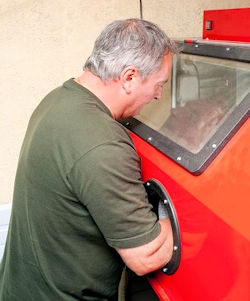Isolation, Containment, and Ventilation
Isolation: Methods can be used to isolate or increase the distance between the employee and the point of work can reduce exposure levels.

For instance, modifications in construction work methods for pouring, casting, finishing and installing concrete can reduce the amount of grinding required, which, in turn, can lower exposures.
Employee Positioning: Where possible, exposures can be reduced if employees work from a position that minimizes exposure. For instance, greater distance from the grinding point, especially when grinding on ceilings and sanding drywall when the dust can fall directly on the employee.
If the grinder is attached to an adequately supported pole, the employee can manipulate the grinder at a distance from one side where the dust is less concentrated. While this method does not eliminate exposure, it can help reduce the amount of dust in the employee's breathing area.
Ventilated containment structures: Exhaust ventilation systems in containment structures can be effective in capturing and removing silica dust. However, task requirements may make this method infeasible. Both the structure and exhaust systems should be properly designed to be effective.
Ventilation Booths: A booth (with fan) erected around a saw can help reduce dust, but may require some experimentation. For example, one employer built a plywood booth around the saw and installed a large exhaust fan at the rear wall to pull dust away from the employee, who operated the saw through an opening in the front of the booth.
Fans: Fans are not effective dust control devices when used as the sole control method and should not be used as the primary method for managing dust. Fans can, however, be useful as a supplement to other control methods. Use fans in enclosed areas, such as bathrooms, where dust would build up due to poor air circulation.
Vacuums for general cleaning: Vacuums offer a versatile option for collecting dry debris from smooth and uneven surfaces, cracks, expansion joints and irregular shapes. Wet/dry vacuums can also collect water, slurry, and damp materials. Use pneumatic vacuums where electricity is not available.
Vacuums do not produce the clouds of dust often generated during dry sweeping or blowing with compressed air, but they are not dust-free. Vacuum cleaners with inadequate or damaged filters can increase employee silica dust exposures due to the agitating action of the vacuum and incomplete filtration of fine dust particles. Employers should choose vacuum filter media carefully.
Knowledge Check Choose the best answer for the question.
3-6. Which of the following should NOT be used as the primary method for managing silica dust?
You forgot to answer the question!
